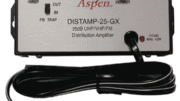Yes, it is, except when it isn’t. A customer recently asked us a question about this. I’ve changed some of the details to preserve their privacy, but it basically goes like this:
I want to run 75 feet of RG11 cable to my antenna, but then connect 3 feet of RG6 on each side so my rotator works well. The RG11 is just too stiff to use from end to end. Will this work?
Well…. I answered,
Yes it will work, but is it really the best bet? Let’s take a look at the facts.
A little bit about signal loss
In order to properly measure signal loss over a cable, you need to know at least three things: (1) what kind of cable it is, (2) what is the highest frequency the cable is carrying, and (3) how long is the cable. Of course manufacturing comes into play and there is also loss from the connectors, but for now let’s focus on these three points.
What kind of cable?
Coaxial cables were originally classified by the US military by the thickness of their center conductor, the amount of foam dielectric in them, and the way they are shielded. Technically these original standards are obsolete but they’re so common that everyone uses them anyway.
RG6 cable is the standard for most RF communications in homes and small offices. It’s flexible enough to work in small spaces, well-made enough to carry power as well as signal, and it’s just a basically all-purpose cable.
RG11 cable is a little more special purpose. It’s almost twice as thick as RG6 cable. It’s designed to have a lot less loss at high frequencies and long lengths. In practice, it’s very rarely used because it is so hard to work with. In the kind of applications you see in homes and small offices, you can easily compensate for the extra loss of RG6 cable using today’s clean digital amplifiers.
What frequencies does it carry?
Regular TV signals go up to about 700MHz today, although frequencies in the 600-700 range are being transferred to cellular in the future.
Cell phones use frequencies all the way up to 2100MHz, as do satellite signals.
As frequencies go up, you lose more signal over distance. This has to do with the increased energy it takes to create more waves in the signal. It’s sort of how you get more tired if you run fast than if you walk.
How long?
Well, we know that in this case the total run is 81 feet (75 + 3 at each end.)
So what does this mean?
Let’s just measure the loss on this cable run. I use this calculator but there are other ones on the web. I’ve just been using this one for years and it works.
The first scenario is 75 feet of RG11, plus 6 feet of RG6. We’ll use 750MHz for now so as to be conservative.
75 feet of RG11 has 2.69dB of loss at 750MHz.
6 feet of RG6 has .34dB of loss at 750MHz.
This means the total loss attributed to the cable is 3.03dB.
Now let’s look at the second scenario, which is 81 feet of RG6. This math is easier.
The total loss attributed to the cable is 4.55dB.
So, this means that the RG11 cable gives you about 1.5dB less loss than the RG6, right?
Hold on a minute though…
In order to connect those RG6 pieces to the RG11 you’ll need two barrel connectors and four more connectors (one on each end of each piece of RG6. Normally we don’t even worry about loss from these pieces because they’re typically about .5dB. But if you multiply .5 by 6 (two barrels + four connectors) that means potentially 3dB more loss from connectors. Now this is a worst case scenario and you can use barrels designed for less loss if you want.
So the real answer is that potentially, the RG11 run has 6.03dB of loss, while the RG6 run has only 4.55dB. It’s easy to see that the RG6 isn’t just the easier choice, but it’s also the better choice.
This is definitely a case where overthinking things isn’t worth it.
For the right cables…
you’ll definitely want to check out the great selection at Solid Signal. If you do truly need commercial quality cables for long runs, we have the best selection, and we’re the best choice on the web for all the accessories you need, too!





